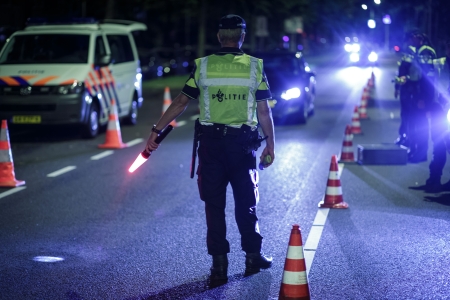Below you will find the list of references that are used in this fact sheet. All sources used can be consulted or retrieved via our Library portal. Here you can also find more literature on this subject.
[1]. Ministerie van VenJ (2012). Inrichtingsplan Nationale Politie. Ministerie van Veiligheid & Justitie, Den Haag.
[2]. Terpstra, J., Duijneveldt, I. van, Eikenaar, T., Havinga, T., et al. (2016). Basisteams in de Nationale Politie - organisatie, taakuitvoering en gebiedsgebonden werk. Politie & Wetenschap, Vaksectie Strafrecht en Criminologie, Faculteit Rechtsgeleerdheid, Radboud Universiteit Nijmegen, Apeldoorn.
[3]. Ministerie van JenV (2019). Uitwerking Veiligheidsagenda 2019 – 2022. Vastgesteld in het LOVP van 3 december 2018. Ministerie van Justitie en Veiligheid, Den Haag.
[4]. Goldenbeld, C., Stelling-Kończak, A. & Kint, S. van der (2019). Verkeershandhaving op Nederlandse autosnelwegen. Evaluatie van de werkwijze van het Team EVT, de effecten en de acceptatie van politiecontroles. R-2019-13. SWOV, Den Haag.
[5]. VNG (2016). Handhaving sterk in de openbare ruimte. Omdat de burger dat van ons verwacht. VNG-visie handhaver 2020. Vereniging van Nederlandse Gemeenten, Den Haag.
[6]. VNG (2016). Bestuurlijke boeteoverlast in de openbare ruimte en lichte verkeersovertredingen (domein 1 Openbare ruimte). Vereniging van Nederlandse Gemeenten, Den Haag.
[7]. CVOM (2015). Leidraad Handhavingsplan Verkeer 2016-2018. Parket Centrale Verwerking Openbaar Ministerie, Afdeling Beleid & Strategie, Openbaar Ministerie, Utrecht.
[8]. CJIB (2015). Ruim 8 miljoen verkeersovertredingen in 2014. Retrieved on 17-06-2019 at https://www.cjib.nl/ruim-8-miljoen-verkeersovertredingen-2014
[9]. CJIB (2016). Bijna 8 miljoen verkeersovertredingen in 2015. Retrieved on 17-06-2019 at https://www.cjib.nl/bijna-8-miljoen-verkeersovertredingen-2015.
[10]. Ministerie van Financiën (2016). Interdepartementaal Beleidsonderzoek Verkeershandhaving. Ministerie van Financiën, Den Haag.
[11]. Goldenbeld, C. & Houwing, S. (2015). Staandehoudingen in het verkeer; Signalering van achtergronden en ontwikkelingen in de verkeershandhaving. Interne SWOV-notitie.
[12]. NOS (2017). Aantal alcoholcontroles afgelopen drie jaar gehalveerd. NOS. Retrieved on 04-06-2019 at https://nos.nl/artikel/2156235-aantal-alcoholcontroles-afgelopen-drie-jaar-gehalveerd.html.
[13]. Adminaite, D., Jost, G., Stipdonk, H. & Ward, H. (2016). How traffic law enforcement can contribute to safer roads. PIN Flash Report 31. European Transport Safety Council ETSC.
[14]. OM (2018 ). Tekstenbundel voor misdrijven, overtredingen en Muldergedragingen. Openbaar Ministerie, Den Haag.
[15]. Wolswijk, H.D., Postma, A. & Keulen, B.F. (2017). Ernstige verkeersdelicten. Rijksuniversiteit Groningen, Groningen.
[16]. Goldenbeld, C. (2005). >Verkeershandhaving in Nederland; Inventarisatie van kennis en kennisbehoeften. [Traffic enforcement in the Netherlands; an inventory of knowledge and knowledge needs]. R-2004-15. Summary in English]. SWOV, Leidschendam.
[17]. Goldenbeld, C., Wijk, A.P. van & Mesken, J. (2013). Sancties in het verkeer. Een vergelijking tussen het terrein van de verkeersveiligheid en de jeugdcriminaliteit. [Sanctions in traffic. Scientific essays on sanctions in and outside traffic] R-2013-10 [Summary in English]. SWOV, Leidschendam.
[18]. Goldenbeld, C. & Twisk, D.A.M. (2009). Verkeersovertredingen, veelplegers en verkeersonveiligheid. Kennis uit bestaand onderzoek. [Traffic offences, multiple offenders and road safety. Knowledge from existing research]. R-2009-7 [Summary in English]. SWOV, Leidschendam.
[19]. Goldenbeld, C., Reurings, M.C.B., Norden, Y. van & Stipdonk, H.L. (2011). Relatie tussen verkeersovertredingen en verkeersongevallen. [The relation between traffic offences and road crashes. Preliminary study making use of Central Fine Collection Agency (CJIB) data]. R-2011-19 [Summary in English]. SWOV, Leidschendam.
[20]. Mathijssen, M.P.M. (1994). Rijden onder invloed in Nederland, 1992-1993; Ontwikkeling van het alcoholgebruik van automobilisten in weekendnachten. R-94-21 [Summary in English]. SWOV, Leidschendam.
[21]. Wagenaar, A.C., Maldonado-Molina, M.M., Erickson, D.J., Ma, L., et al. (2007). General deterrence effects of U.S. statutory DUI fine and jail penalties: Long-term follow-up in 32 states. In: Accident Analysis & Prevention, vol. 39, nr. 5, p. 982-994.
[22]. Briscoe, S. (2004). Raising the bar: can increased statutory penalties deter drink-drivers? In: Accident Analysis & Prevention, vol. 36, nr. 5, p. 919-929.
[23]. Moffatt, S. & Poynton, S. (2007). The deterrent effect of higher fines on recidivism: Driving offences. In: Crime and Justice Bulletin 2007, vol. 106.
[24]. Pogarsky, G. & Piquero, A.R. (2003). Can Punishment Encourage Offending? Investigating The “resetting” Effect. In: Journal of Research in Crime and Delinquency, vol. 40, nr. 1, p. 95-120.
[25]. Bar-Ilan, A. & Sacerdote, B. (2001). The response to fines and probability of detection in a series of experiments. Working Paper 8638. National Bureau of Economic Research. NBER, Cambridge, Massachusetts.
[26]. Moolenaar, D.E.G., Zuidema, T. & Boer, J. de (2011). De afname van het aantal boetes en transacties voor verkeersovertredingen nader verklaard. Cahier 2011-9. WODC, Den Haag.
[27]. Elvik, R. & Christensen, P. (2007). The deterrent effect of increasing fixed penalties for traffic offences: The Norwegian experience. In: Journal of Safety Research, vol. 38, nr. 6, p. 689-695.
[28]. Nichols, J.L., Tippetts, A.S., Fell, J.C., Auld-Owens, A., et al. (2010). Strategies to increase seat belt use: An analysis of levels of fines and the type of law. DOT HS 811 413. NHTSA, Washington.
[29]. Bieleman, B., Boendermaker, M., Mennes, R. & Snippe, J. (2014). Hard op weg. Onderzoek naar verkeersveelplegers. Politiekunde 65, Politie en Wetenschap. Reed Business, Amsterdam, Apeldoorn.
[30]. Hoekstra, A.T.G., Eenink, R.G. & Goldenbeld, C. (2017). Progressief boetestelsel en verkeersveiligheid. Geschatte veiligheidseffecten van hogere boetes bij herhaalde snelheidsovertredingen. [Progressive penalty system and road safety. Estimated safety effects of progressive fines for repeated speeding offences]. R-2017-3 [Summary in English]. R-2017-3. SWOV, Den Haag.
[31]. Vlakveld, W. (2018). Maatregelen tegen afleiding bij automobilisten. Een literatuurstudie. [Measures against distraction of drivers. A literature study]. R-2018-22 [Summary in English]. SWOV, Den Haag.
[32]. Ferdinand, A.O., Menachemi, N., Sen, B., Blackburn, J.L., et al. (2014). Impact of texting laws on motor vehicular fatalities in the United States. In: American Journal of Public Health, vol. 104, nr. 8, p. 1370-1377.
[33]. Ferdinand, A.O., Menachemi, N., Blackburn, J.L., Sen, B., et al. (2015). Government, law, and public health pratice. The impact of texting bans on motor vehicle crash-related hospitalizations. In: American Journal of Public Health, vol. 105, nr. 5, p. 859-865.
[34]. Abouk, R. & Adams, S. (2013). Texting bans and fatal accidents on roadways: Do they work? Or do drivers just react to announcements of bans? In: American Economic Journal: Applied Economics, vol. 5, nr. 2, p. 179-199.
[35]. Aarts, L.T., Loenis, B., Korving, H. & Guiking, C. (2017). Risicofactoren op 50km/uur-kruispunten met verkeerslichten. Methodologische verdieping en verdere verkenning van de kwantificering van risicofactoren zoals roodlichtnegatie. [Risk factors at 50 km/h intersections with traffic lights. Methodological follow-up and further exploration of the quantification of risk factors such as red light runningrunning] R-2017-21 [Summary in English]. SWOV, Den Haag.
[36]. Perkins, C., Steinbach, R., Edwards, P., Beecher, D., et al. (2017). Red light enforcement cameras to reduce traffic violations and road traffic injuries. College of Policing and the Economic and Social Research Council (ESRC), London.
[37]. Goldenbeld, C., Daniels, S. & Schermers, G. (2019). Red light cameras revisited. Recent evidence on red light camera safety effects. In: Accident Analysis & Prevention, vol. 128, p. 139-147.
[38]. SWOV (2016). In 2015 75 tot 140 verkeersdoden als gevolg van alcohol. SWOV. Retrieved on 05-06-2018 athttps://www.swov.nl/nieuws/2015-75-tot-140-verkeersdoden-als-gevolg-van-alcohol
[39]. I&O Research (2018). Rijden onder invloed in Nederland in 2002-2017: ontwikkeling van het alcoholgebruik van automobilisten in weekendnachten. Ministerie van Infrastructuur en Waterstaat, Water, Verkeer en Leefomgeving WVL, ‘s-Gravenhage.
[40]. Minister van VenJ (2017). Antwoorden op Kamervragen over het aantal alcoholcontroles in het verkeer. Brief aan Tweede kamer. Ministerie van Justitie en Veiligheid, Den Haag.
[41]. Erke, A., Goldenbeld, C. & Vaa, T. (2009). The effects of drink-driving checkpoints on crashes—A meta-analysis. In: Accident Analysis & Prevention, vol. 41, nr. 5, p. 914-923.
[42]. Veisten, K., Houwing, S. & Mathijssen, R. (2010). Cost-benefit analysis of drug driving enforcement by the police. Deliverable D3.3.1 of the EU FP6 project DRUID. European Commission, Brussels.
[43]. Steinbach, R., Perkins, C., Edwards, P., Beecher, D., et al. (2016). Speed cameras to reduce speeding traffic and road traffic injuries. Cochrane Injuries Group, London School of Hygiene & Tropical Medicine, London.
[44]. Høye, A. (2014). Speed cameras, section control, and kangaroo jumps–a meta-analysis. In: Accident Analysis & Prevention, vol. 73, p. 200-208.
[45]. Blom, M., Blokdijk, D. & Weijters, G. (2017). Recidive na een educatieve maatregel voor verkeersovertreders of tijdens een Alcoholslotprogramma. Cahier 2017-15. Wetenschappelijk Onderzoek- en Documentatiecentrum WODC, Den Haag.
[46]. SUPREME (2007). Thematic report: Rehabilitation and diagnostics. Directorate-General for Transport and Energy (TREN), European Commission, Brussels.
[47]. Slootmans, F., Martensen, H., Kluppels, L. & Meesmann, U. (2017). Rehabilitation courses as alternative measure for drink-driving offenders. European Road Safety Decision Support System, developed by the H2020 project SafetyCube. Retrieved on 09-11-2018 at www.roadsafety-dss.eu.
[48]. Goldenbeld, C. (2017). Licence suspension. European Road Safety Decision Support System, developed by the H2020 project SafetyCube. Retrieved on 09-11-2018 at www.roadsafety-dss.eu.
[49]. Vis, M.A., Goldenbeld, C. & Bruggen, B. van (2010). Rijden zonder geldig rijbewijs in Nederland. Hoe vaak komt het voor en wat betekent het voor de verkeersveiligheid? [Driving without a valid licence in the Netherlands. How frequent is it and what does it mean for road safety?] R-2010-13 [Summary in English]. SWOV, Leidschendam.
[50]. Miller, P.G., Curtis, A., Sonderlund, A., Day, A., et al. (2015). Effectiveness of interventions for convicted DUI offenders in reducing recidivism: A systematic review of the peer-reviewed scientific literature. In: The American journal of drug and alcohol abuse, vol. 41, nr. 1, p. 16-29.
[51]. Averill, F., Brown, T.G., Robertson, R.D., Tchomgang, A., et al. (2018). Transdermal alcohol monitoring combined with contingency management for driving while impaired offenders: A pilot randomized controlled study. In: Traffic injury prevention, vol. 19, nr. 5, p. 455-461.
[52]. Nieuwkamp, R., Martensen, H. & Meesmann, U. (2017). Alcohol interlock. European Road Safety Decision Support System, developed by the H2020 project SafetyCube. Retrieved on 01-03-2018 at www.roadsafety-dss.eu.
[53]. Elder, R.W., Voas, R., Beirness, D., Shults, R.A., et al. (2011). Effectiveness of Ignition Interlocks for Preventing Alcohol-Impaired Driving and Alcohol-Related Crashes: A Community Guide Systematic Review. In: American Journal of Preventive Medicine, vol. 40, nr. 3, p. 362-376.
[54]. Bjerre, B. & Thorsson, U. (2008). Is an alcohol ignition interlock programme a useful tool for changing the alcohol and driving habits of drink-drivers? In: Accident Analysis & Prevention, vol. 40, nr. 1, p. 267-273.
[55]. Gustafsson, S. & Forsman, A. (2016). Utvärdering av alkolås efter rattfylleri: enkätstudie [Evaluation of a Swedish alcohol interlock program for drink driving offenders: questionnaire study]. VTI-code: 35-2016; summary in English. VTI, Linköping.
[56]. Minister van JenV en IenW (2018). Aanpak rijden onder invloed van alcohol. Kamerstuk 29 398 nr. 588. Brief regering dd. 7 maart 2018.
[57]. McKnight, A.S., Fell, J.C. & Auld-Owens, A. (2012). Transdermal alcohol monitoring: Case studies. Report No. DOT HS 811 603. National Highway Traffic Safety Administration, Washington, DC.
[58]. Tison, J., Nichols, J.L., Casanova, T. & Chaudhary, N.K. (2015). Comparative study and evaluation of SCRAM use, recidivism rates, and characteristics. DOT HS 812 143. Department of Transportation DOT, National Highway Traffic Safety Administration NHTSA, Washington, D.C.
[59]. Grapperhaus, F. (2018). Kamerbrief Evaluatie eerste pilotjaar Alcoholmeterv. Kamerbrief 2445831. Ministerie van Justitie en Veiligheid.
[60]. Pas, J.W.G.M. van der, Kessels, J., Veroude, B.D.G. & Wee, B. van (2014). Intelligent speed assistance for serious speeders: The results of the Dutch Speedlock trial. In: Accident Analysis & Prevention, vol. 72, p. 78-94.
[61]. Pas, J.W.G.M. van der, Kessels, J., Vlassenroot, S.H. & Wee, B. van (2014). The pros and cons of Intelligent Speed Adaptation as a restrictive measure for serious speed offenders. In: Transportation Research Part A: Policy and Practice, vol. 67, p. 158-174.
[62]. Bolderdijk, J.W., Knockaert, J., Steg, E.M. & Verhoef, E.T. (2011). Effects of Pay-As-You-Drive vehicle insurance on young drivers’ speed choice: Results of a Dutch field experiment. In: Accident Analysis & Prevention, vol. 43, nr. 3, p. 1181-1186.
[63]. Goldenbeld, C. & Reurings, M.C.B. (2012). Kansrijkheid van beloningsscenario's in de provincie Limburg.[Feasibility of reward scenarios in the province of Limburg. An assessment based on literature]. D-2012-2 [Summary in English]. SWOV, Leidschendam.
[64]. Hagenzieker, M.P. (1999). Rewards and road user behaviour. An investigation of the effects of reward programs on safety belt use. Doctoral thesis Rijksuniversiteit Leiden, Leiden.
[65]. Hagenzieker, M.P. (2005). Beloning voor veilig rijden. In: Het Tijdschrift voor de Politie, vol. 66, nr. 10, p. 29-32.
[66]. Ministerie van IenM (2016). Beantwoording motie Hoogland plan van aanpak snorfietsoverlast en motie De Rouwe evaluatie maatregelen snorfietsoverlast. Brief 31 oktober 2016 aan de voorzitter van de Tweede Kamer der Staten-Generaal. Ministerie van Infrastructuur en Milieu, Den Haag.
[67]. Goldenbeld, C., Groot-Mesken, J. de & Zwan, S. van der (2014). Inventarisatie van handhavings- en educatieprojecten gericht op de bromfiets. [Survey of enforcement projects and education projects aimed at moped riders]. R-2014-4 [Summary in English]. SWOV, Den Haag.
[68]. MuConsult (2019). Effect van handhaving in het verkeer. Snelheid, roodlichtnegatie, alcohol en afleiding. MuConsult, Amersfoort.
[69]. RWS (2018). Publiekspanel Rijkswegen Noord. Resultaten peiling 4 december 2017. Rijkswaterstaat Noord-Nederland, Leeuwarden.

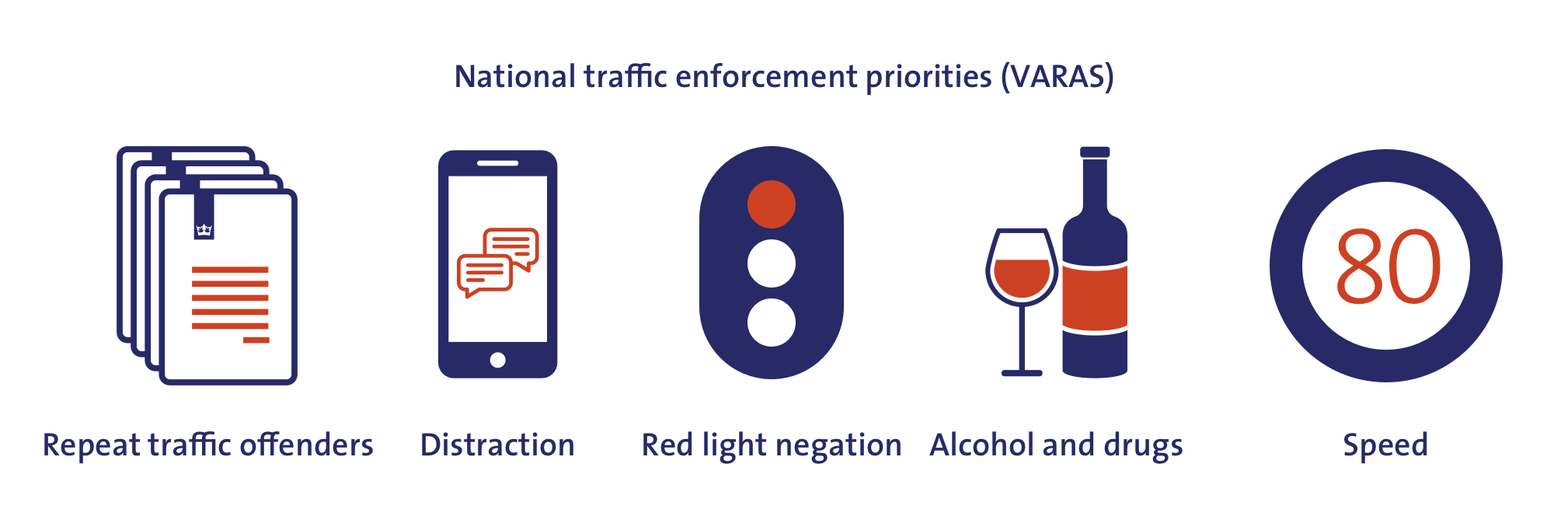
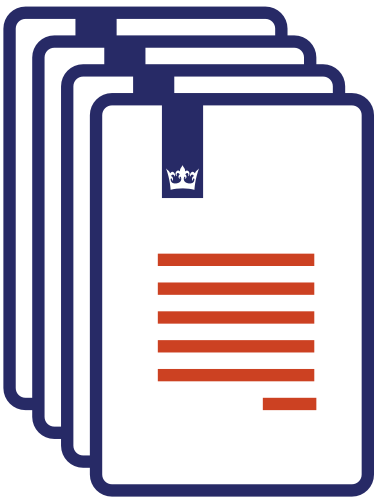 In the Netherlands, research was done into the effect of warning letters to repeat offenders (defined as individuals who often receive fines for annoying or anti-social traffic behaviour). This showed that these warnings led to fewer violations
In the Netherlands, research was done into the effect of warning letters to repeat offenders (defined as individuals who often receive fines for annoying or anti-social traffic behaviour). This showed that these warnings led to fewer violations  In the Netherlands, several dozens to well over a hundred road deaths in car crashes involve distraction (also see SWOV fact sheet
In the Netherlands, several dozens to well over a hundred road deaths in car crashes involve distraction (also see SWOV fact sheet  A 2017 meta-analysis
A 2017 meta-analysis 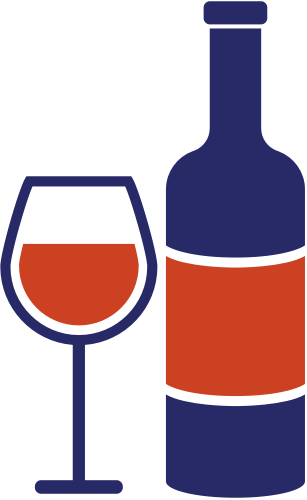 Between 2003 and 2017, the percentage of drivers with an over-the-limit Blood Alcohol Content (BAC) decreased from 3.4% to 1.4%. The share of serious offenders (a BAC > 1.3 ‰) remained at a steady 0.6 to 0.4%. In 2011, it decreased to 0.3% and in 2017 to 0.1%
Between 2003 and 2017, the percentage of drivers with an over-the-limit Blood Alcohol Content (BAC) decreased from 3.4% to 1.4%. The share of serious offenders (a BAC > 1.3 ‰) remained at a steady 0.6 to 0.4%. In 2011, it decreased to 0.3% and in 2017 to 0.1% 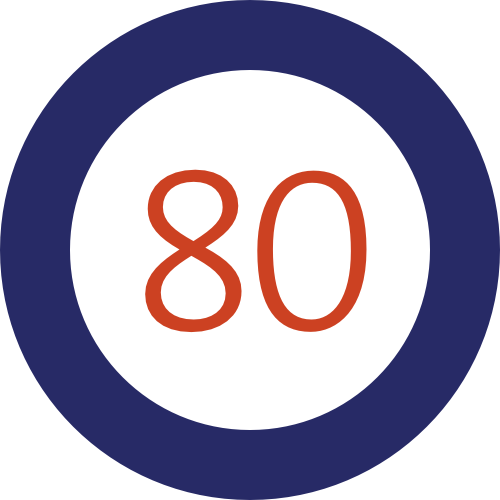 A meta-analysis of studies on speed enforcement
A meta-analysis of studies on speed enforcement 